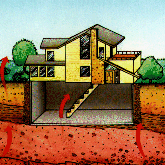Radioactive Radon
 Radon is a gas produced by the radioactive decay of the element radium. Radioactive decay is a natural, spontaneous process in which an atom of one element decays or breaks down to form another element by losing atomic particles (protons, neutrons, or electrons). When solid radium decays to form radon gas, it loses two protons and two neutrons. These two protons and two neutrons are called an alpha particle, which is a type of radiation. The elements that produce radiation are called radioactive. Radon itself is radioactive because it also decays, losing an alpha particle and forming the element polonium.
Radon is a gas produced by the radioactive decay of the element radium. Radioactive decay is a natural, spontaneous process in which an atom of one element decays or breaks down to form another element by losing atomic particles (protons, neutrons, or electrons). When solid radium decays to form radon gas, it loses two protons and two neutrons. These two protons and two neutrons are called an alpha particle, which is a type of radiation. The elements that produce radiation are called radioactive. Radon itself is radioactive because it also decays, losing an alpha particle and forming the element polonium.
The decay of each radioactive element occurs at a very specific rate. How fast an element decays is measured in terms of the element 'half-life', or the amount of time for one half of a given amount of the element to decay. Uranium has a half-life of 4.4 billion years, so a 4.4-billion-year-old rock has only half of the uranium with which it started. The half-life of radon is only 3.8 days. If a jar was filled with radon, in 3.8 days only half of the radon would be left. But the newly made daughter products of radon would also be in the jar, including polonium, bismuth, and lead. Polunium is also radioactive - it is this element, which is produced by radon in the air and in people's lungs, that can hurt lung tissue and cause lung cancer.
Fact Credit
USGS General


